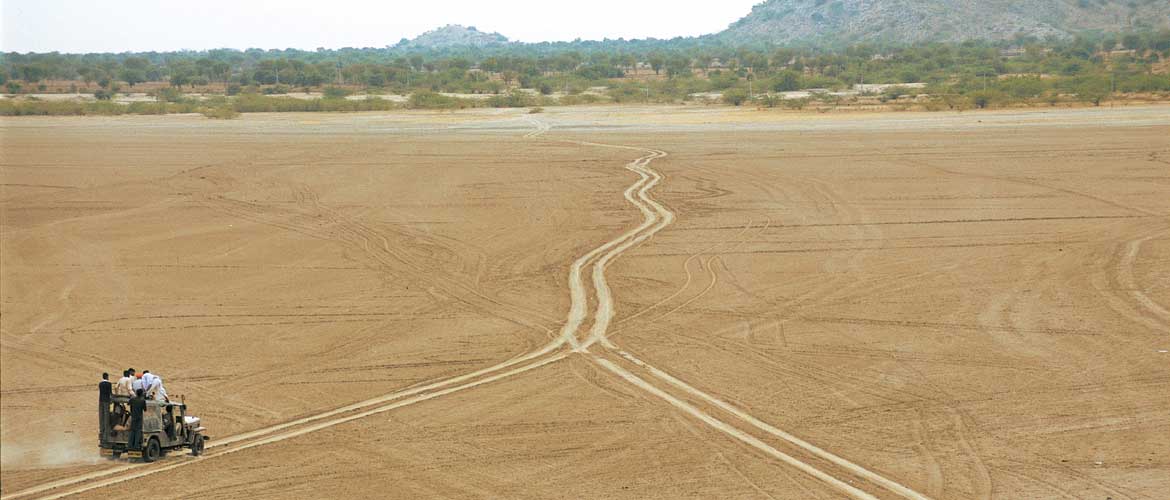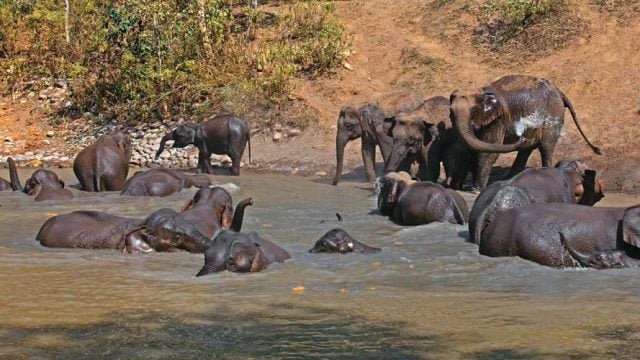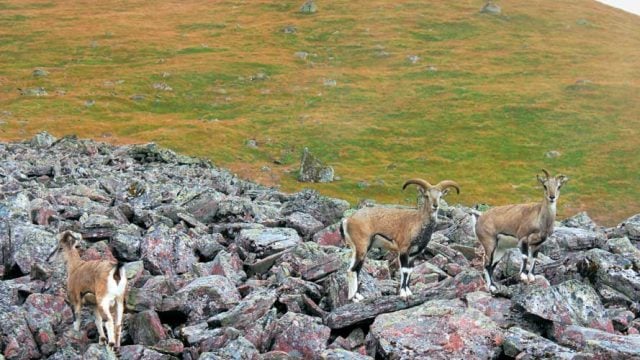It’s five in the evening, and the sun is about to set. The searing heat
There’s little sign of water here. All you can see is a vast bed of compacted soil, sprawling for miles into the horizon. In the backdrop, the craggy Aravalli Hills add colour of the barren landscape. As the sky turns darker, lights in the small towns and villages are switched on.
The stillness is broken by a sudden honking of a large flurry of flamingos; as they take flight, the pink outline of their feathers glow in the last rays of the sun.
I’ve been in Sambhar city for three days now, and have seen hundreds of flamingos, yet every new encounter with these awkward-looking birds, is as exciting as the first time I had spotted them.
The Sambhar Salt Lake straddles the districts of Nagaur, Jaipur and Ajmer. It spreads over an area of 190sq km. For most of the year the lake remains dry. After the monsoons, however, a thin film of water covers the western reservoir, attracting local residents such as painted storks and spot-billed pelicans. Huge colonies of other birds also congregate in the centre of the reservoir.
By October, much of the water evaporates, leaving behind small puddles. The treacherously wet sand is an ideal terrain for waders such as pied avocets, Kentish plovers and black-winged stilts. This is also where the flamingos breed, building their circular, 1-ft-high nests in areas near Ratan Talao. During the day, a couple of hundred birds can be found feeding in the kyars (salt pans), near the Jhapog Dam and in pools near Sambhar town.
Come November, migratory birds start flocking the area. Shovellers, pochards, common teals and pintails gather in hundreds in the less saline ponds. November to mid-March is also the best season for tourists, to come to Sambhar. The cool weather allows plenty of wandering.
By mid-March, most part of the lake dries out, making it easier for tourists to walk or drive (in certain areas). One can even walk on the lake bed and feed the birds. Though dry, the terrain is also less dusty at this time of the year, and dense foliage of babul trees lining the lake offer a good shade.
I had visited Sambhar city in late March. I wasn’t expecting much in this trip, but the evening walks, plenty of birdwatching and simply wandering around the town was exciting enough. On one of my walks, I came across a raucous group of children playing cricket in the sand, while a few men stood by a dhaba enjoying tea. Only a kilometre ahead, when I had almost given up on spotting any birds, I saw a flock of at least 400 flamingos, dabbling their feet in a shallow pool of water. I was barely 300ft away from them.
These white and pink coloured birds poised on their tall dainty legs wandered cautiously along the pond. Some preened, while others balanced themselves nonchalantly on a single leg, and some spotted me, struggling to take a photograph at that moment.
The next morning, I was up before sunrise. Sitting in the verandah of the circuit house, I could almost see the rocky outline of the lake. As the dawn broke, I set out for a walk, wandering through the dusty lanes of Sambhar city, going past old havelis and kirana shops. It is advisable to return before breakfast, as it gets hot after that. Dusty winds make venturing out during the day quite troublesome.
For the next four months, the lake remains dry and there are hardly any birds around it.
ABOUT SAMBHAR SALT LAKE
The ephemeral water body is the largest lake in India (however, the last time the lake was full was in 1985). It’s a shallow wetland with depths varying from 1.6–6.6ft. The lake is not a protected area, but it was declared a Ramsar Site in 1990 and identified for conservation action under the Indian Wetland Conservation Programme.

The lake is owned by the state government, but a large part of it is leased to Sambhar Salts Limited, a salt manufacturing unit. Such units have been a cause of worry for conservationists, who say that it has adversely affected the lake’s ecosystem. Poor rainfall has also aided in the depleted water levels.
ORIENTATION
The Sambhar Salt Lake lies at an altitude of 1,181ft, and gets an average rainfall of 54cm. In the years that witness heavy monsoons, the average depth of water in the lake has been a few centimetres. The maximum has been recorded at 10ft. The length of the lake basin is 22.5km, while its width varies from from 3.2km–11.2km. A 5-km-long dam runs from north to south, dividing the lake between Jhapog and Gudha villages. The western part of the lake is an undisturbed reservoir. The Sambhar Lake on the east is used by salt refining factories. One can see huge mounds of salt in the area beside the lake.
A metalled road connects all the towns situated on the banks of the lake. The road from Sambhar city to the Shakhambari Mata Mandir via Jhapog and Pipla ki Dhani is very rough in parts. There is another track that connects Shakhambari Mata Mandir and Kuchaman via Korsina, Badun and Manglana. This dirt track should only be used during daytime as it is accident-prone.

Sambhar, the small dusty city on the south-eastern bank of the lake, is the only sizeable habitation in the area. A series of roads branch out from the town – two of which skirt the boundaries of the lake while the others lead to the salt pans. Salt production is the main occupation in Sambhar – the town has little else to offer. And while there are no professional tour guides in Sambhar, people (especially taxi drivers) usually help tourists with directions, and locations of bird colonies.
THINGS TO SEE AND DO
Since Sambhar is not a wildlife sanctuary or a national park, it has almost nothing in terms of tourist infrastructure. There are no marked trails around the lake. A trip to Sambhar is essentially for birding.
The drive
The best way to see the lake is to drive around it. It’s possible to drive on most parts of the western reservoir. Two-wheelers must stick to the well-trodden routes, four-wheelers can venture off these, but proceed with caution as parts of the lake can have extremely soft mud.
Driving on the lake bed can confuse you with directions. Also, hire a jeep from Sambhar city for a day to roam around. They are available for hire at the New Bus Stand, and cost ₹650 for 6–7 hours.
Birdwatching
Give yourself at least three to four days in Sambhar if you are interested in birdwatching. Given the size of the lake, and the fact that pockets of water can be extremely localised and far apart, it will probably take you one day to get the necessary information and orient yourself. The sheer size of the lake can often make it difficult to get close to the birds; a good pair of binoculars is, therefore, essential. If you are going to be driving around the lake, try to obtain a detailed map of the lake from Sambhar Salts Limited.
Once you’re done with birding you might want to take a ride on the trolley run by Sambhar Salts Limited. It costs Rs.500 for a few hours, and can take you either to the new kyars or the Devyani kyars.
A visit to the Shakhambari Mata Mandir, on the southern banks of the lake, is also worthwhile. From the hillock behind the mandir, you get a stunning view of mile upon mile of salt flats. Priests at the Shakhambari Mata Temple are well-versed with the history and geography of the area. They will tell you where bird colonies can be found and also regale you with some interesting mythological stories associated with this place. Alternatively, the manager of Sambhar Salts Limited can also provide you with some useful details about the area.
WHERE TOSTAY AND EAT
There are limited options in Sambhar and around, so be prepared for basic facilities. If you want to get to the lake early in the morning (which is when you’ll spot most birds), you should definitely stay in Sambhar.
The Circuit House (Tel: 01425-224249/ 18; Tariff: ₹300–700), run by Sambhar Salts Limited, is basic but very comfortable, and has lovely views of the lake. It was under renovation at the time of going to print. A mess is available for meals. For reservations, contact MS Rawat of Sambhar Salts Limited. They are also the best people to contact for information on the lake. The only other stay option is the Tati Dharamshala, which offers AC rooms. There are a few restaurants offering vegetarian meals only. There are also a few dhabas near the bus stand.
AROUND SAMBHAR
Makrana (90km)
The marble town of Makrana makes for an interesting side trip. Literally everything you get in the shops here is made from the marble that comes from the huge mines (also worth visiting) near the town. The journey takes about 1.5hrs to drive till Makrana via Nawa, Mithri and Kuchaman. You can also plan a day trip from Jaipur.
GETTING THERE
Air Nearest airport: Jaipur 118km/ 2hrs. Connected by bus and train. Taxi fare to Sambhar is ₹1,000 for a day-trip
Rail Nearest railhead: Sambhar Salt Lake Station. Although there are many trains that connect Sambhar city to Jaipur, you can take the one that leaves Jaipur at 5.25am and reaches Sambhar around 6.45am. You can return to Jaipur by a 2.45pm train
Tip It’s best to go to Sambhar by road from the Jaipur Sindhi Camp Bus Stand. Catch any one of the express buses heading to Nagaur or Kuchaman – Sambhar is the first main stop
Road From Delhi, take NH8 to Jaipur (256km). Then take the Jaipur bypass (50km out of the city) and continue on the highway till Ajmer. At Dudu (77km from Jaipur), take a right off the highway. There are a few petrol pumps beyond this point, so make sure that you tank up before leaving the highway. The route from Dudu to Sambhar is via Naraina (13km). The road can be bad in stretches. The total driving time to Sambhar from Delhi is about 6.5hrs
FAST FACTS
When to go November–March is an ideal season to visit. Avoid the monsoons Best sightings October to February, when the migratory birds flock here
Tip No permits are required to visit Sambhar. Since the Sambhar Salt Lake is not a notified area, there is no wildlife/ tourist office
STD code 01425
State Rajasthan
Location Between Jaipur and Ajmer along NH8; spread over 190sq km of the Sambhar Basin, with the Aravalli Hills skirting its north-western edge
Distance 104km SW of Jaipur, 64km NE of Ajmer
Route from Jaipur NH8 to Dudu via Bagru; state highway to Sambhar Salt Lake via Naraina
OT Getaway Guides
Rajasthan
Sambhar Salt Lake





